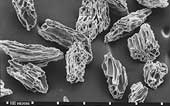
|
|
Related Documents
Download Options
| Image Name | Width x Height | Size |
|---|---|---|
| SIA3125.jpg | 96K |
Caption
These volcanic glass shards are found in a layer of ash known as the Rockland ash bed. These tiny glass shards are "pumiceous" because they consist of many gas-bubble holes (called "vesicles") that formed as gas dissolved in the magma expanded rapidly during eruption, similar to the vesicles contained in pumice. In the ash shards at left, some of the vesicles are oval and others are stretched into long, thin "capillary" tubes.
The ash was erupted about 600,000 years ago, probably by Brokeoff Volcano, northwest of Lassen Peak. The eruption produced local pyroclastic flows and widespread ash fall over western North America and the Pacific Ocean. Scientists have estimated that more than 120 km3 of tephra was produced by this eruption, greater than that of the Mount Mazama eruption about 7000 years ago that formed Crater Lake, Oregon. The Rockland ash bed is found at many sites throughout northern California, northern Nevada, southern Oregon, and as far east as southeastern Idaho.